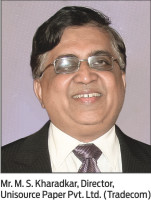Paper has many faces. Intricate processes of finishing and converting render the paper those many faces; handling ensures the faces reach the user intact.
 The ultimate usability of paper depends on a number of factors. The rolls of paper produced by the paper machine must still undergo a number of operations before the paper becomes useful to the consumer. These various operations are referred to as converting and finishing and often make use of intricate and fast-moving machinery. The major operation of paper manufacturing is supported and reinforced by these many manifest and latent processes of finishing, converting, and handling which ensure the paper is used the way it is meant to be.
The ultimate usability of paper depends on a number of factors. The rolls of paper produced by the paper machine must still undergo a number of operations before the paper becomes useful to the consumer. These various operations are referred to as converting and finishing and often make use of intricate and fast-moving machinery. The major operation of paper manufacturing is supported and reinforced by these many manifest and latent processes of finishing, converting, and handling which ensure the paper is used the way it is meant to be.
Paper Mart, underscoring the criticality of these operations, planned to do a feature focusing major suppliers of various crucial machines and paper manufacturers or specialized converters who use these machines in their operations. Excerpts:
 Paper Mart: First thing first, how important are the operations-finishing, converting and handling- for paper industry and why is it so?
Paper Mart: First thing first, how important are the operations-finishing, converting and handling- for paper industry and why is it so?
M. S. Kharadkar: Finishing, converting and handling of paper are very important components for the paper industry because however good quality paper you manufacture, if it is not finished and packed properly, the customers are hesitant to buy. Only after these operations, the paper goes to the customer and it is necessary that the final product going to the customer is absolutely defect-free.
PM: Beyond finishing and converting, proper handling of paper rolls till it reaches the end user is another crucial parameter. You may be or may not be part of it, yet tell us your opinions on the subject.
MSK: Either rolls or reams, if the paper is not handled properly, it gets damaged and this is a financial loss.
PM: As a converter, how do you ensure that your paper is best handled to customer’s satisfaction?
MSK: We have modern handling equipments like forklifts with paper roll clamps, pallet trucks, etc. The forklifts picks up the paper rolls with the help of its clamps and shifts it swiftly to designated area in the godown/warehouse. These forklifts and clamps are perfectly maintained so that they do not damage the outer layer or the edges of the roll while handling.
We have made it mandatory that core plugs are used so that the rolls are not crushed when they are handled by the forklifts. The forklift drivers are adequately trained to handle the rolls in a proper manner and use the required capacity forklift. For handling paper in sheets which are on metal pallets after sheeting are moved by pallet trucks either for internal movement for finishing/packing /bundling and also for loading in trucks for outward dispatch.
We also ensure that paper after sheeting is packed as quickly as possible that is within few hours so that it is not contaminated with dust and other free moving particles of the atmosphere.
PM: Where does India stand with regards to adoption of standard finishing, converting, and handling practices? How seriously this aspect is considered by the Indian paper manufacturers?
MSK: Presently, only some of the Indian paper mills have taken to adoption of standard finishing, converting and handling practices seriously, and the awareness of importance of finishing, converting, and handling is slowly but surely percolating to other mills.
For a long time, due importance was not given to this aspect. With the customers getting exposed to international standards, they have become more demanding and are now expecting mills to follow these standards in India. Manufacturers and convertors of high value paper are more conscious of standard practices.
PM: What are the major issues related to finishing, converting and handling that both the paper manufacturer and end-users are experiencing in India? What according to you, must be done to address these?
MSK: India needs off line, near-to-market, specialized finishing houses managed by professionals with modern automated sheeters, packing and bundling machines, latest material handling equipments. Mills who make high value papers should outsource these operations for higher efficiency and timely/quick customer service.
Another important aspect is safe transportation. Transporters do not have the requisite awareness of transportation of delicate products like paper. The trucks/containers used for transportation should have smooth floors and side walls to prevent damage to the finished paper.
.
 Paper Mart: First thing first, how important are the operations-finishing, converting and handling- for paper manufacturers and why is it so?
Paper Mart: First thing first, how important are the operations-finishing, converting and handling- for paper manufacturers and why is it so?
Naveen Shrivastava: The finishing and converting is the most vital section in a paper mill. It is the section which produces as how customer will receive it in use. This section is most vital from quality control point of view as well. Some of the process variations and quality defects can be sorted out in this section so customer receives a fault free product.
PM: As a provider of technology for paper mills and converters, what are your offerings with regards to finishing and converting?
NS: Our most important products are Hi-tech Sheet Winder machines form Acelli, Italy and Sheet Cutter from Milltex, Italy. Acelli also provides the rebuild of existing Winders.
PM: Finishing and converting, taken conjointly, comprise different operations at different stages of paper processing. Where does your expertise intervene, and to what end?
NS: We can undertake from Pope reel tambour to sheets. All what is necessary between this can be done by our principals. The most important part is that we can do services and erect machine with our local in-house engineers.
PM: Any product you want to mention as a stand out?
NS: The fully automatic high speed Winders and high precision syncro-fly Sheet Cutters.
PM: Beyond finishing and converting, proper handling and packing of paper rolls till it reaches the end user is another crucial parameter. You may be or may not be part of it, yet tell us your opinions on the subject.
NS: Packing and reel handling are most crucial parts of finishing house. In most of board plants, where the cut sizes are in plenty, this can be main bottleneck. Despite of best decision for machine, it can become a bottleneck as the sizes keep evolving and are dynamic in nature.
PM: Where does India stand with regards to adoption of standard finishing, converting, and handling practices? How seriously this aspect is considered by the Indian paper manufacturers?
NS: The printing industry has seen a sea change in last decade. The quality requirement has gone up with regards to sheet cut precision, high speed printing machine requirements v/s paper quality and its winding quality. This has made the need of quality and precise machines quite vital. There is a need of a different approach towards this section. You may know that in lot of large organizations abroad this is a separate profit center and is often separated from main paper productions, as its Opex and Capex have different approaches as compared to core paper industry.
PM: What are the major issues related to finishing, converting and handling that both the paper manufacturer and end-users are experiencing in India? What according to you, must be done to address these?
NS: A lot of industries are opening satellite industries at customer ends. This often lacks the desired level of quality control. We feel the core industry should have the main finishing plant and the satellite finishing plants should be opened only for retailers.
.
 Paper Mart: First thing first, how important are the operations-finishing, converting and handling- for paper manufacturers and why is it so?
Paper Mart: First thing first, how important are the operations-finishing, converting and handling- for paper manufacturers and why is it so?
Avikshit Aneja: Finishing is one of the most important functions in the paper mill operations, where a general product produced in a paper mill is finished into a special one as per the client’s requirements by chemical/mechanical actions. An instance of chemical action is imparting sizing and coating – which may be single side/ both sides, white/colored. Similarly, by mechanical actions we obtain things such as glossy/matt finish with the help of glossy/soft-nip calendar rolls or super calendar system or cast yankee cylinders. These things that we get from mechanical actions are prominently known as art papers and chromo papers used for labels/photo quality papers/ Inkjet etc.
Converting is another important function, where paper produced in jumbo reels is converted into user friendly shape and size, be it small reels or sheets, for the industrial consumers, ultimately to be used for making notebooks, newsprints, A4 size copier, facial tissue, table napkins, kitchen towels, toilet tissue, pocket tissue, etc. Converting not only makes a product user friendly, but also helps in value addition.
Handling is crucial for ultimate customer’s satisfaction. The reel is wrapped in protective layers of kraft or cellophane paper and pushed or conveyed to the transportation bay with help of chain conveyor. Thereafter, a reel is piled neatly in the truck with help of a fork-lift. A4 copier reams are neatly stacked and wrapped on a wooden pallet and neatly piled in a truck or container with help of a fork-lift. Main purpose of handling is to present the finished product to the user in the right shape and with expected properties so that client satisfaction remains high. This results in customer retention in this competitive era along-with enhancement in the brand image.
PM: As a provider of technology for paper mills and converters, what are your offerings with regards to finishing and converting?
AA: In finishing, we have Normal Size Press for speeds upto 500 MPM; Film Press for paper machine speeds 600 ~ 900 MPM; Coating Sections – Pilot Coating Plants (off-line) along-with on-line coating system comprising of bar/ blade /air-knife combination; Soft Nip Calendar System; and Super Calendar System.
For converting, we have offerings such as Two Drum Rewinders and Single Drum Rewinders for writing & printing, kraft liner, coated duplex board. We also have Special Paper Rewinders namely for tissue paper, cellophane paper, thermal paper; Simplex Sheet Cutter; Duplex Sheet Cutter; Sheeters for A4 and normal size; Wrapmatic Lines; Complete Converting Lines for a tissue mill for making toilet tissue, kitchen towels, facial tissue, printed napkins, n type folder, pocket tissue, etc.; Paper Bag Making Lines; Lines for making paper cup, paper plate, notebook; and Newspaper Printing Machines.
PM: Finishing and converting, taken conjointly, comprise different operations at different stages of paper processing. Where does your expertise intervene, and to what end?
AA: Our expertise span complete paper plant, we can provide end to end solutions, for various grades of paper produced.
PM: Beyond finishing and converting, proper handling and packing of paper rolls till it reaches the end user is another crucial parameter. You may be or may not be part of it, yet tell us your opinions on the subject.
AA: Disfigured and damaged packages are now-a-days treated as rejects by the convertors and retail clients alike; these can’t be sold sometimes even after allowing discounts. This results in a loss to paper mills. Paper mills are nowadays becoming increasingly cautious about it and prefer a multi-layer packing so as to ensure safety of the product.
PM: Where does India stand with regards to adoption of standard finishing, converting, and handling practices? How seriously this aspect is considered by the Indian paper manufacturers?
AA: Needless to mention, cost is an important factor for the adoption of technology. This pressurizes the paper mills to compromise and defer their decisions till the time when the market is good. However, quite a few big mills have already invested in standard international practices and technologies like De-Curlers post Coating, Automatic Wrapmatic Lines & Final Package Handling systems.
Moreover, the availability of trained technicians also plays an important role while taking a call. But, we do hope that the paper mills in India, sooner or later, shall feel the need of going for it.
PM: What are the major issues related to finishing, converting and handling that both the paper manufacturer and end-users are experiencing in India? What according to you, must be done to address these?
AA: The cost of such machinery being high and the pressures on bottom line normally push the paper industry to keep things to manual levels, rather than to go for automatic machines. The Govt. and financial institutions shouldn’t consider the paper industry as a bygone thing and should allow finances at special rates so that they can invest in essential and upcoming technologies to become at par with a world class level.



